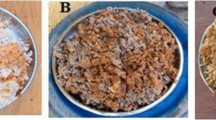Abstract
Tea fungus is symbiotic culture of acetic acid bacteria and yeasts, widely used to produce kombucha tea. Due to the rich biomass in tea fungus, it can be utilized as protein supplement in animal feed. The present study aimed to analyze the biochemical characteristics of tea fungus with the effect of fermentation time. Proximate, amino acids, and elemental analysis of tea fungus produced during kombucha fermentation were studied along with total count of microflora. Results suggested that tea fungus is rich in crude protein, crude fibre, and amino acid lysine. The biochemical characteristics of tea fungus studied were increased throughout the fermentation time.
Similar content being viewed by others
References
Dufresne CJ, Farnworth ER. A review of latest research findings on the health promotion properties of tea. J. Nutr. Biochem. 12: 404–421 (2001)
Blanc PJ. Characterization of tea fungus metabolites. Biotechnol. Lett. 18: 139–142 (1996)
Sreeramulu G, Zhu Y, Knol W. Kombucha fermentation and its antimicrobial activity. J. Agr. Food Chem. 48: 2589–2594 (2000)
Murugesan GS, Sathishkumar M, Swaminathan K. Supplementation of waste tea fungal biomass as a dietary ingredient for broiler chicks. Bioresource Technol. 96: 1743–1748 (2005)
Jayabalan R, Marimuthu S, Thangaraj P, Sathishkumar M, Binupriya AR, Swaminathan K, Yun SE. Preservation of kombucha tea-Effect of temperature on tea components and free radical scavenging properties. J. Agr. Food Chem. 56: 9064–9071 (2008b)
Jayabalan R, Marimuthu S, Swaminathan K. Changes in content of organic acid and tea polyphenols during kombucha tea fermentation. Food Chem. 102: 392–398 (2007)
Jayabalan R, Subathradevi P, Marimuthu S, Sathishkumar M, Swaminathan K. Changes in free-radical scavenging ability of kombucha tea during fermentation. Food Chem. 109: 227–234 (2008)
AOAC. Official Method of Analysis of AOAC Intl. 15th ed. Method 926.08, 923.03, 962.09, 955.04C, 979.09, 922.06, 954.02. Association of Official Analytical Communities, Arlington, VA, USA (1990)
VanSoest PJ. Use of detergents in analysis of fibrous feeds III. Study of affects of heating and drying on yield of fiber and lignin in forages J. Assn. Offic. Agr. Chem. 48: 748–785 (1965)
Reiss J. Influence of different sugars on the metabolism of the tea fungus. Z. Lebensm. Unters. For. 198: 258–261 (1994)
Chen C, Liu BY. Changes in major components of tea fungus metabolites during prolonged fermentation. J. Appl. Microbiol. 89: 834–839 (2000)
Yamada E, Sgarbieri AVC. Yeast (Saccharomyces cerevisiae) protein concentrate: Preparation, chemical composition, and nutritional and functional properties. J. Agr. Food Chem. 53: 3931–3936 (2005)
Rumsey GL, Hughes SG, Smith RR, Kinsella JE, Shetty KJ. Digestibility and energy values of intact disrupted and extracts from dried yeast fed to rainbow trout (Oncorhynchus mykiss). Anim. Feed Sci. Tech. 33: 185–193 (1991)
Rumsey GL, Kinsella JE, Shetty KJ, Hughes SG. Effect of high dietary concentrations of brewer’s dried yeast on growth performance and liver uricase in rainbow trout (Oncorhynchus mykiss). Anim. Feed Sci. Tech. 33: 177–183 (1991)
Ayanwale BA, Ibrahim MJ, Aberuagba F. Utilisation of dried yeast as a source of lysine in broiler feeds. J. Anim. Vet. Adv. 5: 582–584 (2006)
Ayanwale BA, Kpe M, Ayanwale VA. The effect of supplementing Saccharomyces cerevisiae in the diets of egg laying and egg quality characteristics of pullets. Int. J. Poult. Sci. 5: 759–763 (2006)
Choiu PWS, Chiu SW, Chen CR. Value of Aspergillus niger fermentation product as a dietary ingredient for broiler chickens. Anim. Feed Sci. Tech. 91: 171–182 (2001)
Mayser PC, Leitzmann SF, Grunder K. The yeast spectrum of the tea fungus kombucha. Mycoses 38: 289–395 (1995)
Gilvarg C, Bloch K. The utilization of acetic acid for amino acid synthesis in yeast. J. Biol. Chem. 163: 339–346 (1951)
Martini AEV, Miller MW, Martini A. Amino acid composition of whole cells of different yeasts. J. Agr. Food Chem. 27: 982–984 (1979)
Bauer PB, Petrushevska TL. Mineral and water soluble vitamin content in the kombucha drink. Int. J. Food Sci. Tech. 35: 201–205 (2000)
Weber CJ. Biobased Packaging Materials for the Food Industry: Status and Perspectives, Available from: http://www.biomatnet.org/publications/f4046fin.pdf Accessed Jan. 10, 2010.
Czaja W, Krystynowicz A, Bielecki X, Brown RM. Microbial cellulose-the natural power to heal wounds. Biomaterials 27: 145–151 (2006)
Fontana JD, Desouza AM, Fontana CK, Torriani L, Moreschi JC, Gallotti BJ, Desouja SJ, Narcisco GP, Bichara JA, Farah LFX. Acetobacter cellulose pellicle as a temporary skin substitute. Appl. Biochem. Biotech. 24/25: 253–264 (1990)
Machado MD, Santos MS, Gouveia C, Soares HM, Soares EV. Removal of heavy metals using a brewer’s yeast strain of Saccharomyces cerevisiae: The flocculation as a separation process. Bioresource Technol. 99: 2107–2115 (2008)
Machado MD, Janssens S, Soares HM, Soares EV. Removal of heavy metals using a brewar’s yeast strain of Saccharomyces cerevisiae: Advantages of using dead biomass. J. Appl. Microbiol. 106: 1792–1804 (2009)
Parvathi K, Nagendran R, Nareshkumar R. Effect of pH on chromium biosorption by chemically treated Saccharomyces cerevisiae. J. Sci. Ind. Res. 66: 675–679 (2007)
Author information
Authors and Affiliations
Corresponding author
Rights and permissions
About this article
Cite this article
Jayabalan, R., Malini, K., Sathishkumar, M. et al. Biochemical characteristics of tea fungus produced during kombucha fermentation. Food Sci Biotechnol 19, 843–847 (2010). https://doi.org/10.1007/s10068-010-0119-6
Received:
Revised:
Accepted:
Published:
Issue Date:
DOI: https://doi.org/10.1007/s10068-010-0119-6




